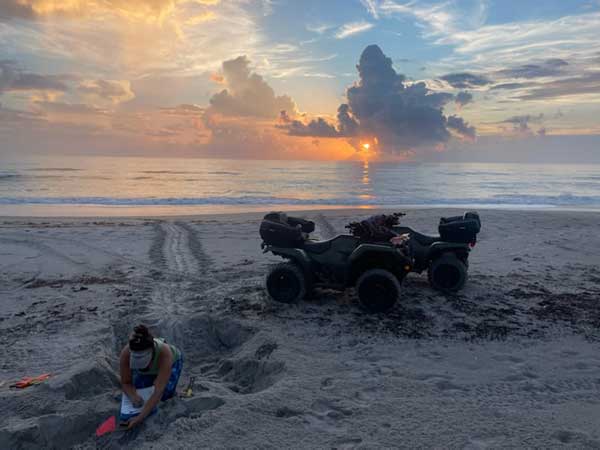Grant: 22-007R
Project Title: Late-season sea turtle nesting in central and south Brevard County, Florida, Year 2
Project Manager: Erin E. Seney, Ph.D.
Organization: University of Central Florida (Research and Educational Institute)
Grant Amount: $9,225.00
Completion Date: 2023-10-12
Summary: The University of Central Florida Marine Turtle Research Group (UCF MTRG) monitors sea turtle activity on densely-nested beaches in Central and South Brevard County, including the northern Archie Carr National Wildlife Refuge. Loggerhead nesting in UCF's survey region typically extends into September, whereas green turtle nesting continues into October-November, but the program's nest marking schemes are designed to be representative of each species' nesting season, thereby limiting required marking during the late season. These late-season nests are most likely to overlap with dune restoration and beach nourishment. In Brevard County, sand placement activities typically occur during November-March, with some projects extending into spring. Nests laid within 65 days of a beach project start date are either marked for avoidance or relocated outside of the construction area. FWC recognizes that late-season nest data are limited and takes a precautionary approach with relocation and inventory schedules. Larger, more recently collected datasets for late-season nests, including expansion of late-season marking conducted in September-November, would help managers set appropriate avoidance marking and relocation windows based on the species' biology, as well as inform other seasonal beach restrictions and nest inventory protocols/. As part of this project, we will increase the number of September-November nests marked, monitored, and inventoried by the UCF MTRG to fill knowledge gaps for late-season nests to better inform management agencies. Results: Though sea turtle nesting on Florida's east coast extends nearly year-round, nests laid in the last months of the loggerhead (Caretta caretta) and green turtle (Chelonia mydas) nesting season, especially after the official "end" of the season (October 31), are historically understudied. Late-season nests are more likely to be impacted by beach renourishment projects typically occurring from November-March. These nests are exposed to lower temperatures, slowing egg incubation duration, and may reduce nest viability and hatching success. With the recent increase in green turtle nesting in Florida, it is likely that late-season nests will become more common and may have an important contribution to population dynamics. The beaches monitored by the University of Central Florida's Marine Turtle Research Group (UCF MTRG) in Brevard County are representative of nesting in the state, hosting about 1 in 6 loggerhead and 1 in 3 green turtle nests, making this an optimal study area. In 2021-2022, the UCF MTRG supplemented its reproductive sampling scheme to include more late-season nests. In 2021, 9 loggerhead and 70 green turtle nests were marked in total during September-November. During 29 August- 3 November 2022, 8 loggerhead and 67 green turtle nests were marked, with nesting surveys still ongoing. Inventory data collected from these nests will be used to describe incubation duration, viability, and reproductive success by species, compared to main season (April-August) nests. Assessments of 2021 nests show late-season nests incubated more slowly and were more susceptible to being washed out than those laid earlier in the season. Nests laid in August-September 2022 were heavily impacted by Hurricane Ian. Results from this research will be useful for determining the contributions of late-season nests to reproductive output, as well as informing nest inventory protocols during cooler months and aiding managers overseeing seasonal beach restrictions.
Results: Though sea turtle nesting on Florida's east coast extends nearly year-round, nests laid in the last months of the loggerhead (Caretta caretta) and green turtle (Chelonia mydas) nesting season, especially after the official "end" of the season (October 31), are historically understudied. Late-season nests are more likely to be impacted by beach renourishment projects typically occurring from November-March. These nests are exposed to lower temperatures, slowing egg incubation duration, and may reduce nest viability and hatching success. With the recent increase in green turtle nesting in Florida, it is likely that late-season nests will become more common and may have an important contribution to population dynamics. The beaches monitored by the University of Central Florida's Marine Turtle Research Group (UCF MTRG) in Brevard County are representative of nesting in the state, hosting about 1 in 6 loggerhead and 1 in 3 green turtle nests, making this an optimal study area. In 2021-2022, the UCF MTRG supplemented its reproductive sampling scheme to include more late-season nests. In 2021, 9 loggerhead and 70 green turtle nests were marked in total during September-November. During 29 August- 3 November 2022, 8 loggerhead and 67 green turtle nests were marked, with nesting surveys still ongoing. Inventory data collected from these nests will be used to describe incubation duration, viability, and reproductive success by species, compared to main season (April-August) nests. Assessments of 2021 nests show late-season nests incubated more slowly and were more susceptible to being washed out than those laid earlier in the season. Nests laid in August-September 2022 were heavily impacted by Hurricane Ian. Results from this research will be useful for determining the contributions of late-season nests to reproductive output, as well as informing nest inventory protocols during cooler months and aiding managers overseeing seasonal beach restrictions.